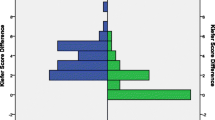Abstract
Background
The in-line combination of adjustable differential pressure valves with fixed gravitational units is increasingly recommended in the literature. The spatial positioning of the gravitational unit is thereby decisive for the valve opening pressure. We aimed at providing data on factors contributing to primary overdrainage and underdrainage of cerebrospinal fluid (CSF), with special attention paid to the implantation angle of the gravitational unit.
Methods
Weretrospectively analyzed the postoperative course of 376 consecutive patients who received a ventriculoperitoneal shunt with a proGAV valve. The incidence of both primary CSF overdrainage and underdrainage was correlated with the implantation angle of the gravitational unit in regard to the Frankfurt horizontal plane and the patients’ general parameters.
Results
Primary overdrainage was found in 41 (10.9 %) patients. Primary underdrainage was found in 113 (30.1 %) patients. A mean deviation of 10° (±7.8) for the gravitational unit in regard to the vertical line to the Frankfurt horizontal plane was found. In 95 % of the cases the deviation was less than 25°. No significant correlation between the implantation angle and the incidence of overdrainage or underdrainage of CSF was found. The patients’ age and having single hydrocephalus entities were identified as factors significantly predisposing patients to overdrainage or underdrainage.
Conclusion
The implantation of the gravitational unit of the proGAV valve within a range of at least 10° in regard to the vertical line to the Frankfurt horizontal plane does not seem to predispose patients to primary overdrainage or underdrainage in ventriculoperitoneal shunting. The plane may serve as a useful reference for the surgeon’s orientation.

Similar content being viewed by others
References
Allin DM, Czosnyka ZH, Czosnyka M, Richards HK, Pickard JD (2006) In vitro hydrodynamic properties of the Miethke proGAV hydrocephalus shunt. Cerebrospinal Fluid Res 3:9
Barbera AL, Sampson WJ, Townsend GC (2009) An evaluation of head position and craniofacial reference line variation. Homo 60(1):1–28
Browd SR, Gottfried ON, Ragel BT, Kestle JRW (2006) Failure of cerebrospinal fluid shunts: part II: overdrainage, loculation, and abdominal complications. Pediatr Neurol 34(3):171–176
Browd SR, Ragel BT, Gottfried ON, Kestle JRW (2006) Failure of cerebrospinal fluid shunts: part I: Obstruction and mechanical failure. Pediatr Neurol 34(2):83–92
Deininger MH, Weyerbrock A (2009) Gravitational valves in supine patients with ventriculo-peritoneal shunts. Acta Neurochir (Wien) 151(6):705–709, discussion 709
Freimann FB, Sprung C (2012) Shunting with gravitational valves-can adjustments end the era of revisions for overdrainage-related events? J Neurosurg. doi: 10.3171/2012.8.JNS1233
Freimann FB, Vajkoczy P, Sprung C (2013) Patients benefit from low-pressure settings enabled by gravitational valves in normal pressure hydrocephalus. Clin Neurol Neurosurg. doi: 10.1016/j.clineuro.2013.06.010
Kaestner S, Kruschat T, Nitzsche N, Deinsberger W (2009) Gravitational shunt units may cause under-drainage in bedridden patients. Acta Neurochir (Wien) 151(3):217–221, discussion 221
Kiefer M, Eymann R, Meier U (2002) Five years experience with gravitational shunts in chronic hydrocephalus of adults. Acta Neurochir (Wien) 144(8):755–767, discussion 767
Leitão P, Nanda RS (2000) Relationship of natural head position to craniofacial morphology. Am J Orthod Dentofac Orthop 117(4):406–417
Lemcke J, Meier U (2010) Improved outcome in shunted iNPH with a combination of a Codman Hakim programmable valve and an Aesculap-Miethke ShuntAssistant. Cent Eur Neurosurg 71(3):113–116
Lemcke J, Meier U, Müller C, Fritsch MJ, Kehler U, Langer N, Kiefer M, Eymann R, Schuhmann MU, Speil A, Weber F, Remenez V, Rohde V, Ludwig HC, Stengel D (2013) Safety and efficacy of gravitational shunt valves in patients with idiopathic normal pressure hydrocephalus: a pragmatic, randomised, open label, multicentre trial (SVASONA). J Neurol Neurosurg Psychiatr 84(8):850–857
Lundström A, Lundström F (1995) The Frankfort horizontal as a basis for cephalometric analysis. Am J Orthod Dentofac Orthop 107(5):537–540
Madsen DP, Sampson WJ, Townsend GC (2008) Craniofacial reference plane variation and natural head position. Eur J Orthod 30(5):532–540
Meier U, Stengel D, Müller C, Fritsch MJ, Kehler U, Langer N, Kiefer M, Eymann R, Schuhmann MU, Speil A, Weber F, Remenez V, Rohde V, Ludwig HC, Lemcke J (2013) Predictors of subsequent overdrainage and clinical outcomes after ventriculoperitoneal shunting for idiopathic normal pressure hydrocephalus. Neurosurgery 73(6):1054–1060
Park J, Kim G-J, Hwang S-K (2007) Valve inclination influences the performance of gravity-assisted valve. Surg Neurol 68(1):14–18, discussion 18
Petricevic N, Celebic A, Celic R, Baucic-Bozic M (2006) Natural head position and inclination of craniofacial planes. Int J Prosthodont 19(3):279–280
Sprung C, Miethke C, Schlosser H-G, Brock M (2005) The enigma of underdrainage in shunting with hydrostatic valves and possible solutions. Acta Neurochir Suppl 95:229–235
Stockhammer F, Miethke C, Knitter T, Rohde V, Sprung C (2013) Flow-related noise in patients with ventriculoperitoneal shunt using gravitational adjustable valves. Acta Neurochir (Wien). doi: 10.1007/s00701-013-1876-9
Toma AK, Tarnaris A, Kitchen ND, Watkins LD (2011) Use of proGAV® shunt valve in normal pressure hydrocephalus. Neurosurgery. doi: 10.1227/NEU.0b013e318214a809
Vienenkötter B, Unterberg A, Aschoff A (2009) Implantation failures and suboptimal positions of gravitational valves - with massive impacts on shunt dysfunction. Cerebrospinal Fluid Res 6(Suppl 2):20
Conflicts of interest
FBF, MLL, VR, PV, and SW have no conflicts of interest to disclose. CS is supported by Aesculap AG to deliver presentations at scientific meetings but has no financial interest in the product this article discusses.
Author information
Authors and Affiliations
Corresponding author
Rights and permissions
About this article
Cite this article
Freimann, F.B., Luhdo, ML., Rohde, V. et al. The Frankfurt horizontal plane as a reference for the implantation of gravitational units: a series of 376 adult patients. Acta Neurochir 156, 1351–1356 (2014). https://doi.org/10.1007/s00701-014-2076-y
Received:
Accepted:
Published:
Issue Date:
DOI: https://doi.org/10.1007/s00701-014-2076-y




